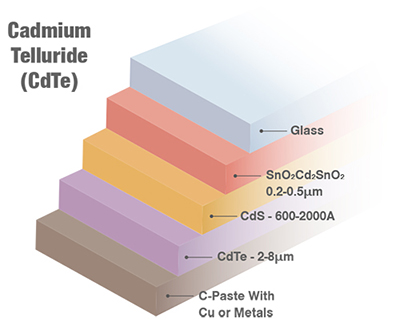Amid the green energy revolution, Building-Integrated Photovoltaics (BIPV) is gaining momentum as a key driver of sustainable development in the construction industry. Among the emerging technologies, cadmium telluride (CdTe) solar glass stands out with its high efficiency, aesthetic appeal, and eco-friendly properties, making it a prominent solution for BIPV applications.
1. Superior Low-Light Performance
CdTe solar glass, known for its excellent photoelectric conversion efficiency, is becoming a flagship product in the BIPV sector. Utilizing a cadmium telluride thin film as the photovoltaic layer, it efficiently converts sunlight into electricity. Compared to traditional silicon-based solar cells, CdTe glass performs well even in low-light conditions, providing a more reliable and stable energy supply for buildings.
Widespread use of CdTe solar glass in buildings not only meets the electricity demands of the structure but can also feed surplus energy back into the grid, ensuring optimized energy usage. This high-efficiency energy solution helps reduce energy consumption and carbon emissions, contributing to the advancement of green buildings.
2. Outstanding Temperature Performance
CdTe thin-film solar cells boast a low-temperature coefficient, demonstrating excellent adaptability to high-temperature environments. Even during hot summers, these cells maintain high efficiency with minimal performance drop. This makes CdTe thin-film cells an ideal solution for energy generation in hot climates, providing strong technical support for green buildings and BIPV applications.
3. Long Lifespan and Stability
CdTe thin-film solar cells also stand out for their exceptional durability and stability in outdoor environments. According to tests from the National Renewable Energy Laboratory (NREL), CdTe modules retained 88% of their original efficiency after 27 years of operation (1995-2021), with only a 12% degradation. In contrast, typical crystalline silicon modules experience around 20% efficiency loss over the same period. This impressive longevity makes CdTe cells a reliable source of sustained energy for green buildings and BIPV.

4. Strong Compatibility with Architecture
One of the key strengths of CdTe solar glass is its customizable design, catering to the creativity of architects and the individual preferences of building owners. Whether in terms of color, texture, or size, CdTe glass can be tailored to seamlessly integrate with the building’s aesthetic. This flexibility allows CdTe solar glass to serve not only as an energy source but also as a design element, enhancing both the functionality and visual appeal of the structure.
5. Excellent Light Transmission
CdTe solar modules integrate cadmium telluride with conductive glass, providing effective light transmission while meeting the building's daylighting needs. Available in various colors, these modules ensure uniform light diffusion, enhancing their visual and practical harmony with the building design.
6. Higher Safety
Traditional solar modules, when partially shaded over time, can suffer from hot spot effects, where local overheating caused by high current can decrease performance and reduce system lifespan. In extreme cases, this can lead to fire hazards. CdTe modules, with their lower current and reduced heat buildup, exhibit minimal hot spot effects, ensuring higher safety and system stability.
7. Minimal Tilt Dependence
CdTe modules excel in diffuse light absorption, making them less dependent on installation angle. Even under extreme angles, CdTe panels maintain superior energy generation compared to other modules, ensuring high energy conversion efficiency in various installation conditions. This feature enhances the flexibility and adaptability of CdTe panels in BIPV applications.
8. Environmental and Sustainability Benefits
CdTe solar glass is manufactured using environmentally friendly materials and techniques, aligning with sustainable development goals. Compared to traditional silicon-based solar cells, CdTe production generates less waste and has a smaller environmental footprint. Moreover, its long lifespan ensures stable performance over time, reducing the need for frequent replacements and minimizing resource consumption and environmental impact.
In summary, CdTe solar glass represents a powerful and sustainable solution for BIPV, offering efficiency, flexibility, safety, and environmental benefits for modern green architecture.







